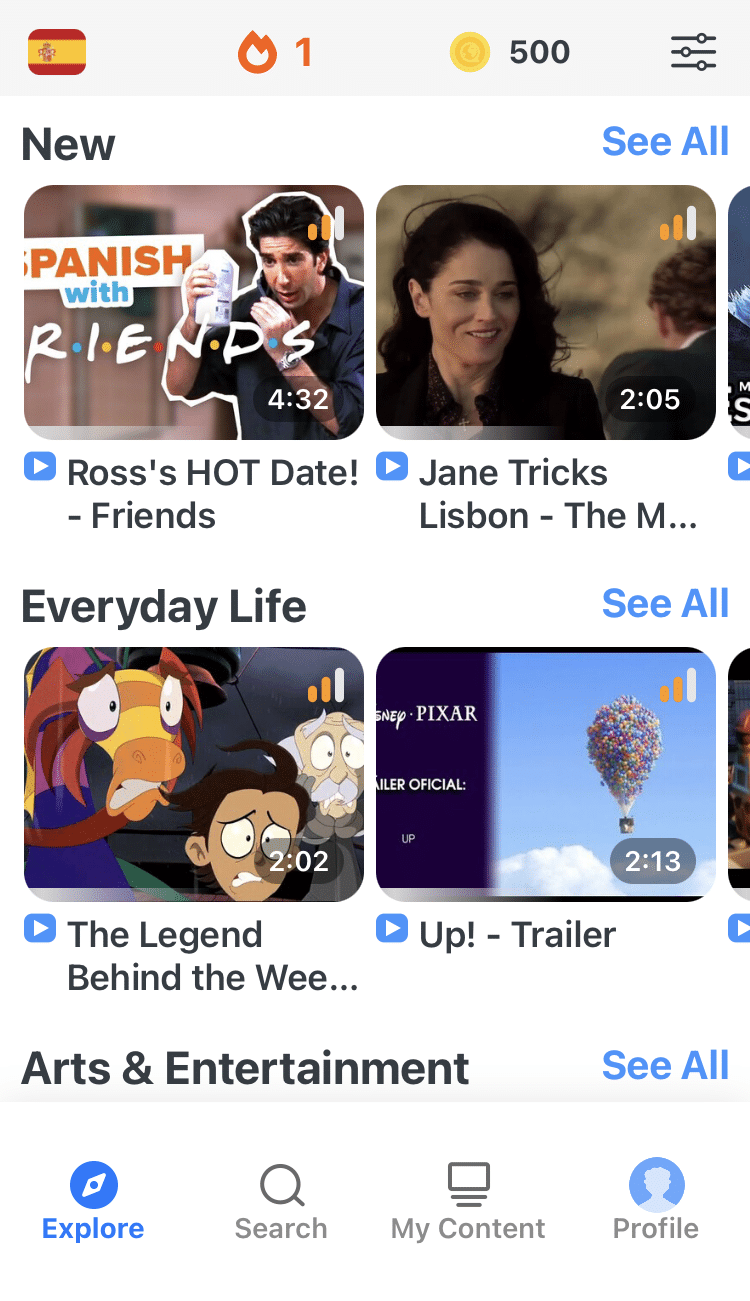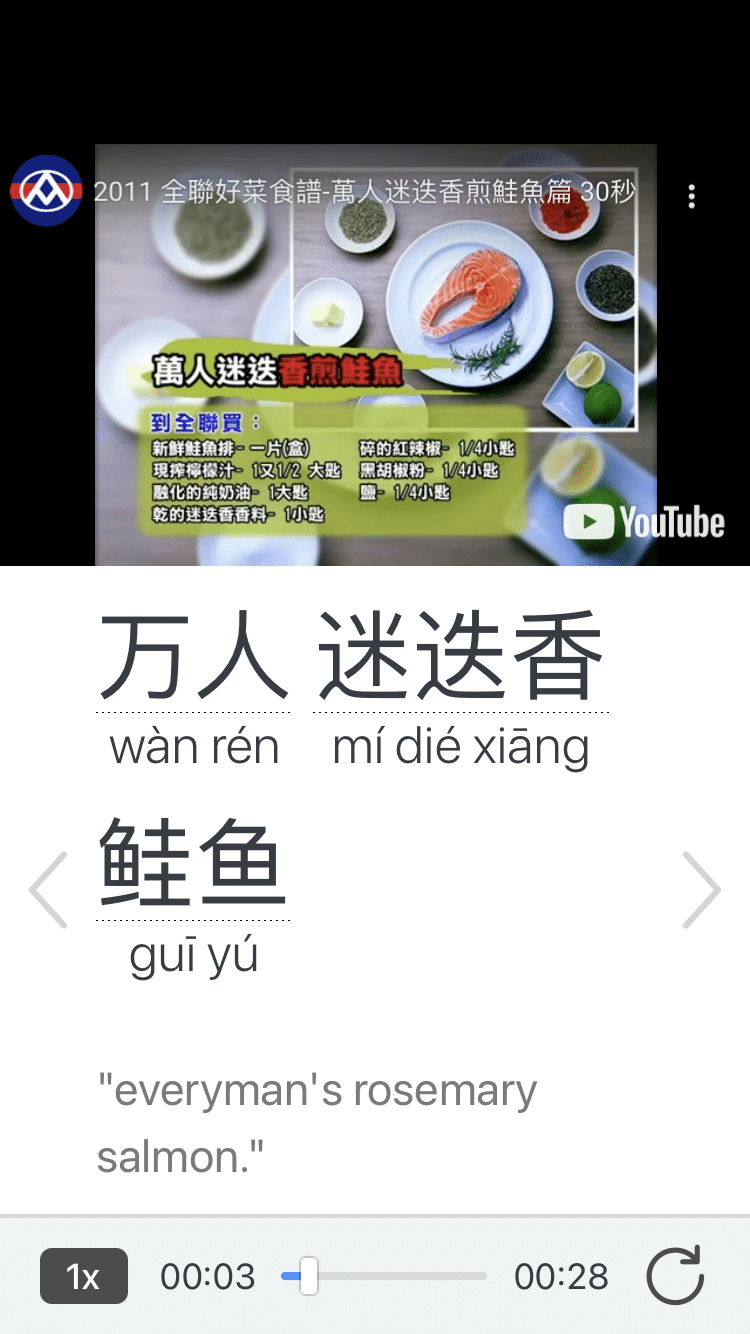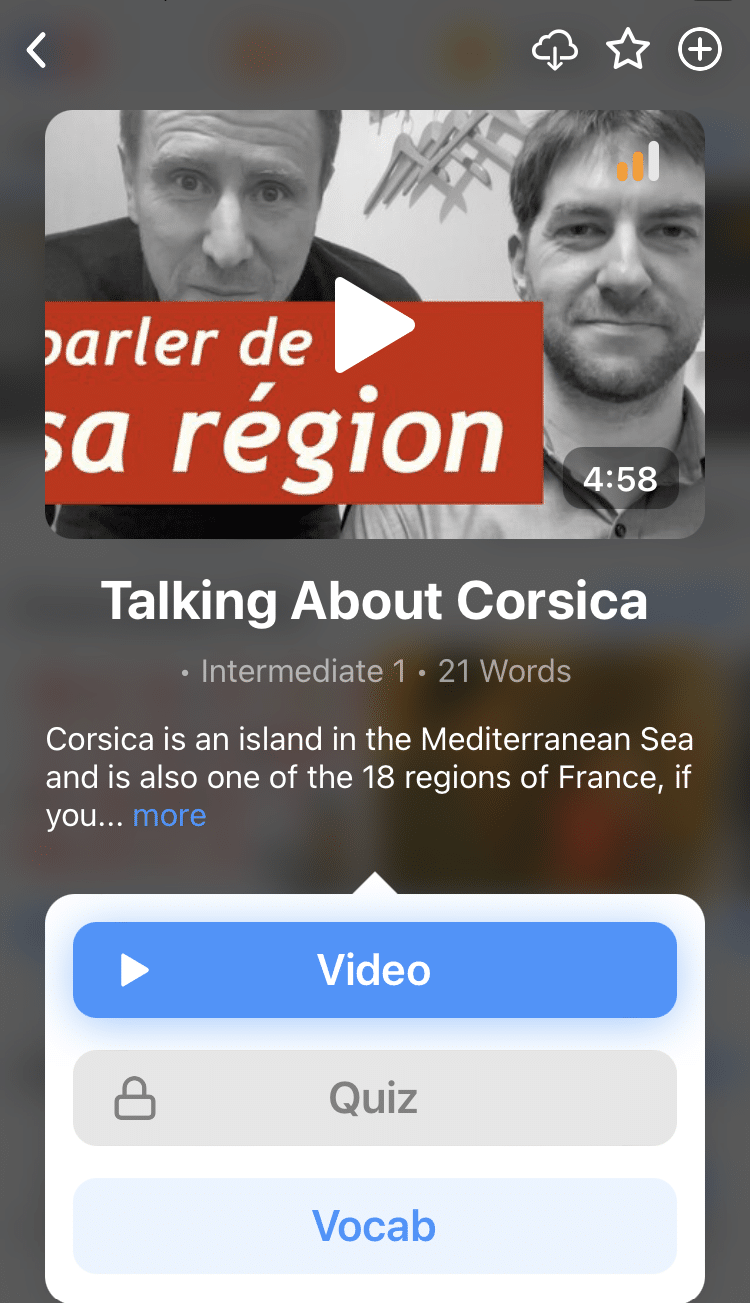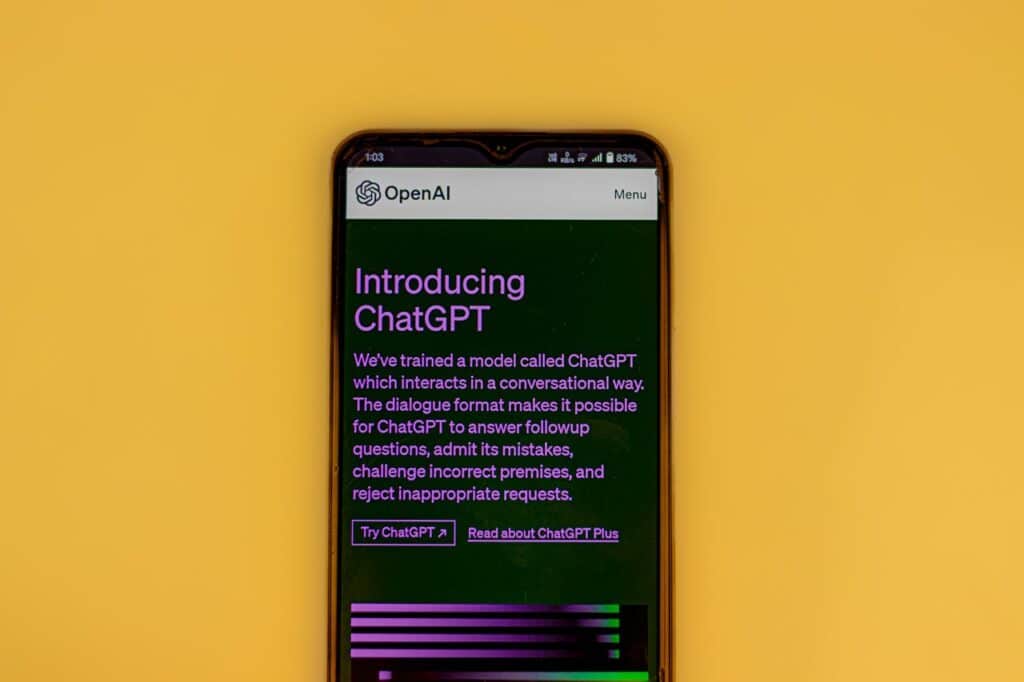
I Tried ChatGPT for Language Learning: Here Are 10 Strategies That Worked
The first time I sent a chat message to ChatGPT, I was intrigued. When I tried doing a voice call with ChatGPT several months later, I was blown away by its language-learning potential.
As a Mandarin language student in Taiwan, I’ve used ChatGPT every day in my journey from A1 to B2.
I’ve picked up a few tricks along the way, so here are 10 ways (with example prompts) to learn a language with ChatGPT.
Contents
- How Effective is ChatGPT for Language Learning?
- 10 Ways to Use ChatGPT for Language Learning
- 1. Explain the differences between words
- 2. Do translations with context
- 3. Generate vocabulary for specific situations
- 4. Correct your grammar
- 5. Practice conversations
- 6. Start a voice diary
- 7. Have it break down sentences
- 8. Create exercises and quizzes
- 9. Come up with graded reader-style stories
- 10. Check out language learning bots
- Common Questions about ChatGPT
- And One More Thing...
Download: This blog post is available as a convenient and portable PDF that you can take anywhere. Click here to get a copy. (Download)
How Effective is ChatGPT for Language Learning?

ChatGPT is an AI language model that was developed by OpenAI, and it was trained on huge datasets of several languages. Since it’s a language model, you can chat with it, and it can give responses that are understandable and even sound human.
The language that ChatGPT is the best at is English. Aside from English, it also does well with languages that are popular online, like Spanish and French. A PhD student from Shanghai even told me that it sounds natural in Mandarin.
Still, for rarer languages, such as Swahili and Icelandic, it’s not as reliable.
While ChatGPT is a fairly new app, there are already research studies about its effectiveness for language learning. For example, research confirms that it can act as a personalized language tutor, give corrections for writing and provide a safe environment for language learners to practice.
One huge drawback is that it sometimes still gives wrong information for “context-based questions,” like rarer idioms or cultural references.
AI is constantly improving, though. If you’re learning a popular language (such as any of the languages tackled here on FluentU), ChatGPT can be a massively helpful study tool.
10 Ways to Use ChatGPT for Language Learning
Here are 10 strategies for learning with ChatGPT that I’ve personally tried and tested. Just note that GPT-4 (the paid, advanced version) does much better than GPT-3.5 (the free version)!
1. Explain the differences between words
If you’ve ever tried learning a language, you’ll definitely encounter words with the same English translation—but they have different meanings for native speakers.
ChatGPT is actually pretty good at breaking down the differences between similar words. For example, all three of the Chinese words below translate to ”change” in English:
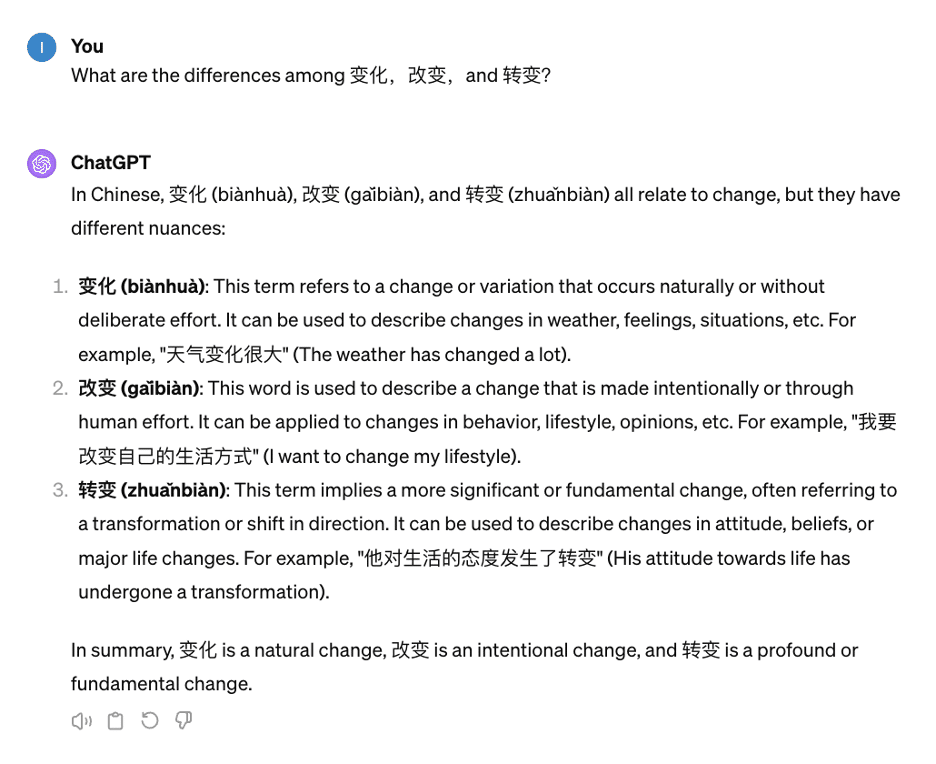
Example Prompts:
- Can you explain the difference between…?
- In which situations would you use…?
2. Do translations with context
ChatGPT—specifically GPT-4—is among the most reliable online apps for translations. It’s way better than Google Translate, and a friend who’s doing her graduate degree in translation told me that they’ve used ChatGPT in class as a starting step for translation projects.
Even better, you can give it context. You can say that the translation might need a formal or a casual tone, or even get specific about what kind of situation it’s being used in. For example, Latin American Spanish can be quite different depending on the country, whether that’s Mexico or Argentina.
Just be aware that ChatGPT usually does a better job translating into English rather than from English to another language.
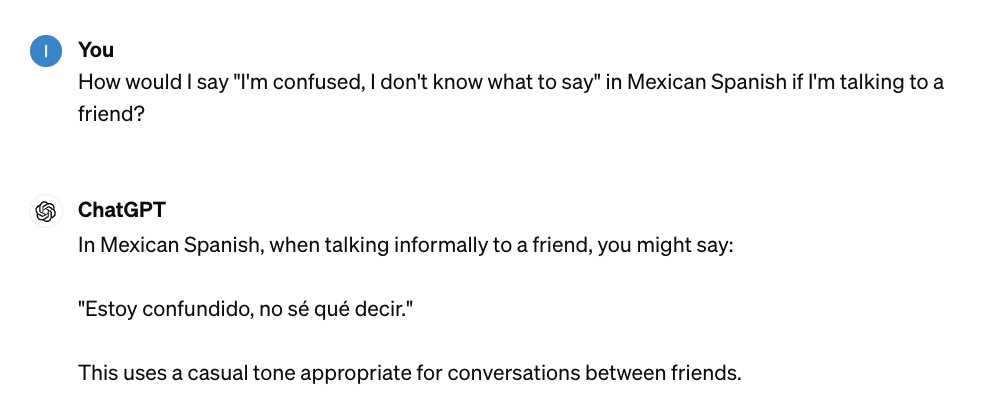
Example Prompts:
- Can you translate… into [language]?
- How would I say… in [language] if I’m talking casually to a friend / for a formal email / in a presentation?
3. Generate vocabulary for specific situations
This is one of the most practical uses for ChatGPT. I needed to get an eye exam done and buy contact lenses in Chinese, and since I didn’t know a lot of medical vocabulary yet (like “astigmatism” and “contact lens solution”), I asked ChatGPT to generate a list of useful vocabulary for me.
It paid off because a lot of the words did come up on the go! I tried this out too with opening a bank account and getting my hair dyed, and it was like being given an instant cheat sheet.
Here’s how this might work in French, for example:
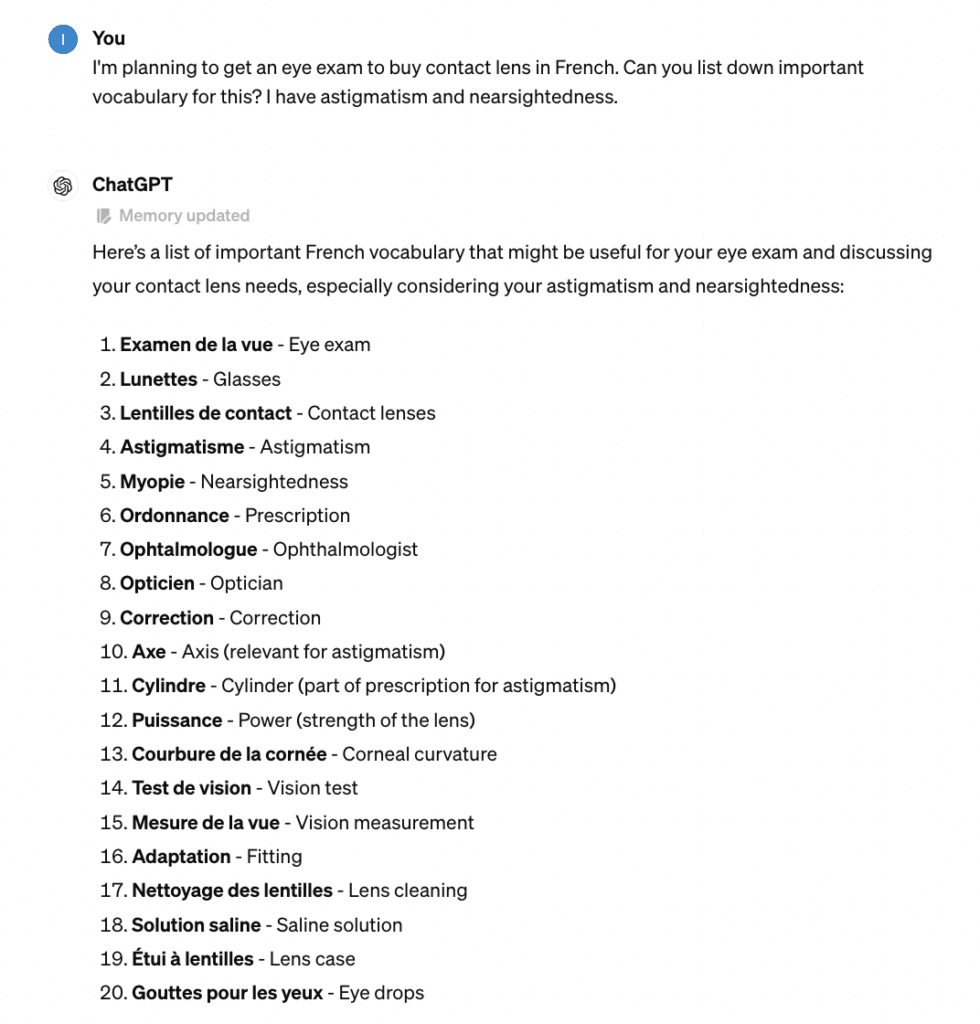
Example Prompts:
- Can you give me important phrases for…?
- What vocabulary should I know for…?
4. Correct your grammar
Want instant feedback on your grammar? Aside from turning to a regular grammar app, you can show your writing in your target language instead to ChatGPT.
Better than a grammar app, it can give you detailed explanations of why your grammar is wrong. By constantly getting feedback like this, you’ll be able to internalize your target language’s grammar rules faster.
Going beyond grammar, you can even have it suggest ways to refine and improve your writing.
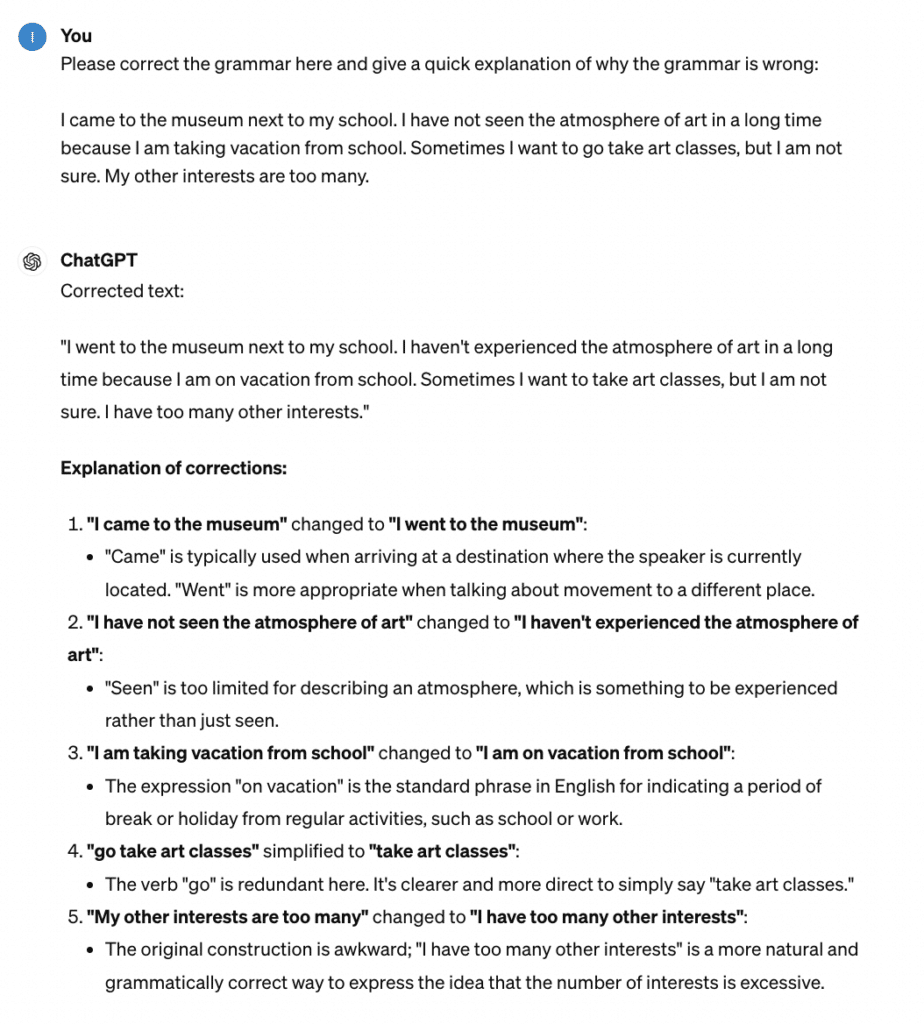
Example prompts:
- Please correct the grammar here and explain why the grammar is wrong.
- Is the tense / conjugation correct in this sentence?
- I am learning [language]. Give tips on how to smooth out this paragraph and make it sound closer to how a native speaker would write.
5. Practice conversations
Everyday life, politics, art, book discussions and even just making up silly imaginary scenarios—ChatGPT can be your conversation partner for all of this.
This isn’t just about playing around with a chatbot, either. Many top language learning apps, including Duolingo and Memrise, have already included ChatGPT-based lessons on their app.
If you have GPT 4, take it one notch higher and have phone calls with ChatGPT, where you can speak and listen in your target language. It’s no substitute for talking to (and making friends with) a native speaker, but you can still get a lot of practice done.
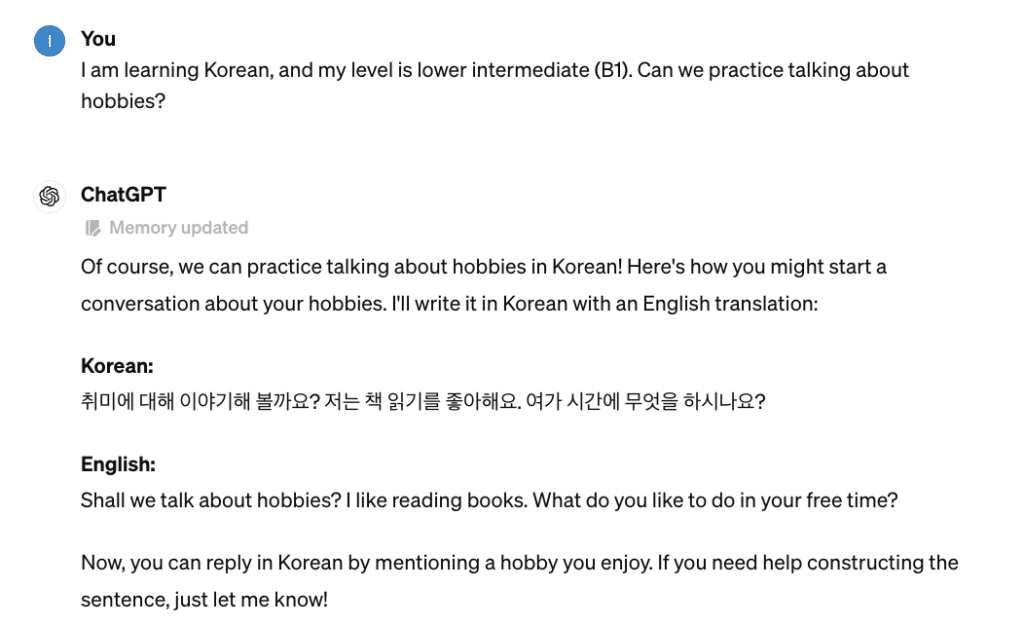
Example Prompts:
- I am learning [language], and my level is [beginner/intermediate/advanced]. Can we practice talking about [topic]?
- Let’s talk about [topic]. I am currently a [language] learner, please correct me when I make mistakes during our conversation.
- Can we role-play a [situation] in [language]?
6. Start a voice diary
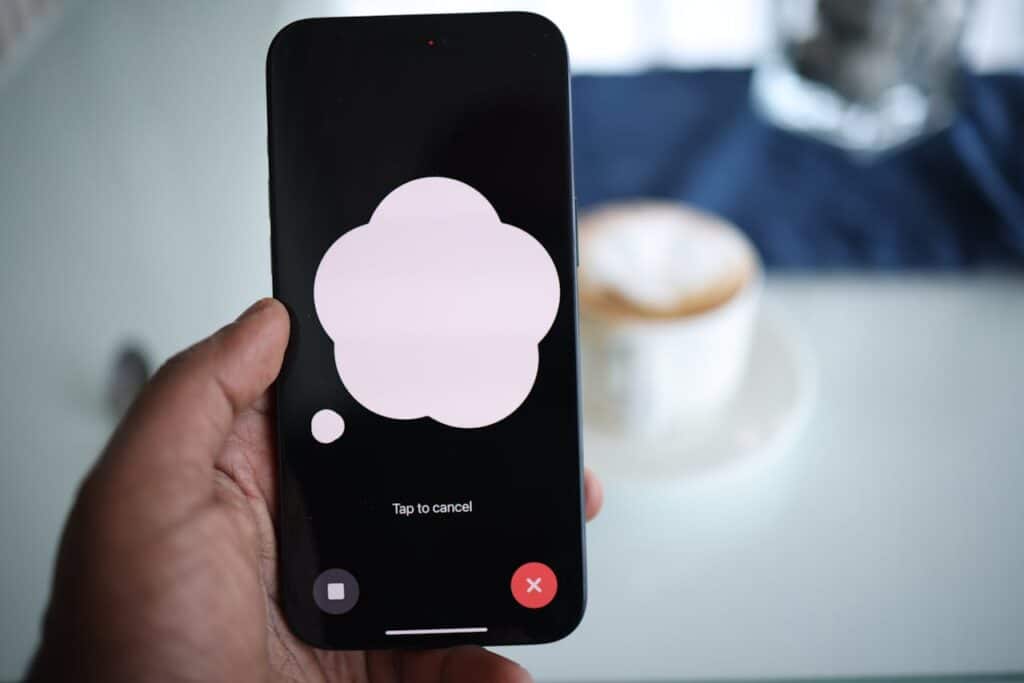
Making a daily diary in your target language is time-tested language learning advice. With GPT 4, you can challenge yourself by doing a voice diary, where you narrate your day out loud in your target language.
Of course, this isn’t one-sided—assign ChatGPT to ask you reflection questions afterwards.
If you’re talking about how a job interview went for you in Spanish, it might ask you: “So what did you learn about your experience?” or “How hopeful are you about getting the job?”
Example Prompts:
- I want to practice [language]. I’ll describe an experience, then please ask me reflection questions afterwards.
- I’m learning [language], and I want to practice by talking about [situation]. Afterwards, ask me follow-up questions about it.
7. Have it break down sentences
As a language learner, this is going to sound all too relatable. You’re staring at a sentence, and you want to scratch your head because you know what the individual words mean but can’t piece together what the sentence is saying as a whole. Or you’ve already checked the dictionary and it still doesn’t make sense.
I’ve actually turned to ChatGPT fairly often for help with this. You can give it the mysterious sentence, and it’ll explain how each part of the sentence works along with the overall meaning.
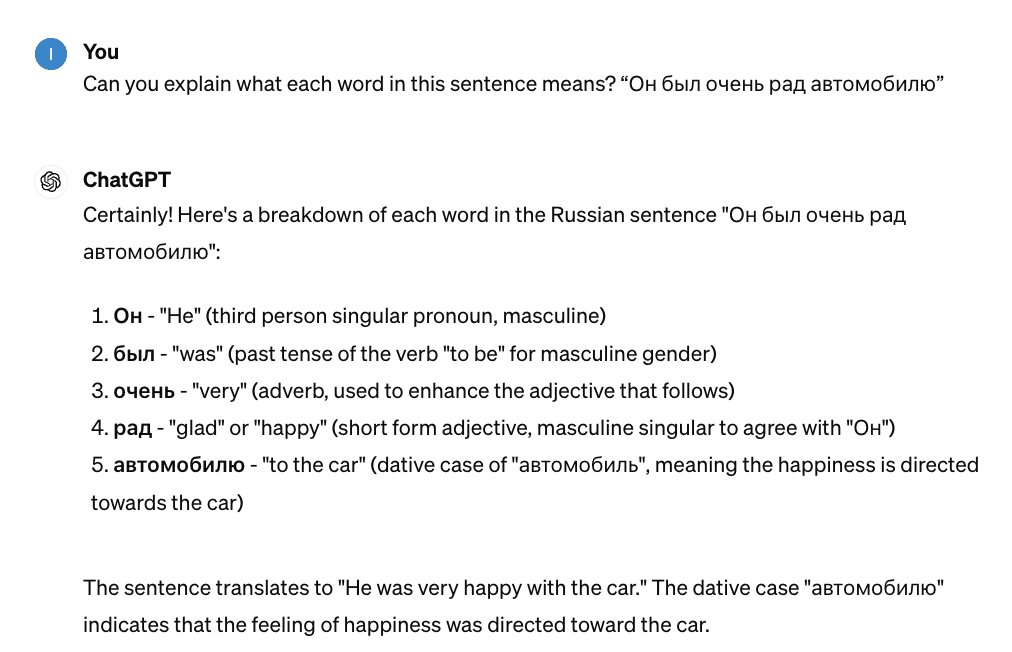
Example Prompts:
- Can you explain the meaning of this sentence, then break it down word per word?
- Please break down the sentence… Explain the role and meaning of each word, along with the grammar structures used.
8. Create exercises and quizzes
Alongside flashcard apps like Anki, I’ve prepped for exams with ChatGPT by having it come up with mini-quizzes.
It can still get wonky with multiple-choice and fill-in-the-blank questions, but it’s great at making translation exercises (for practicing grammar points).
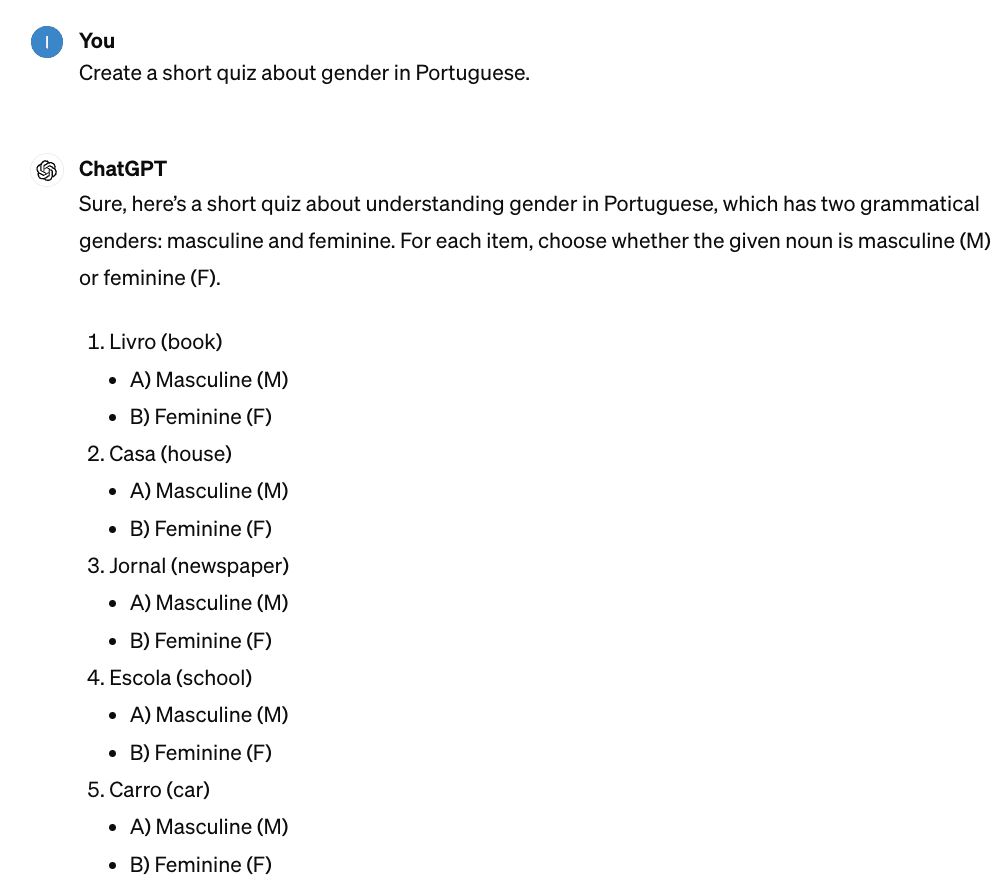
Example Prompts:
- Create a quiz about…
- Come up with translation exercises to help me practice…
- Create a conjugation exercise for [verb].
9. Come up with graded reader-style stories
ChatGPT can be a pretty wacky storyteller, especially if you give it the right prompts. You can harness this for language learning by having it act like a graded reader.
Give it a list of vocabulary or grammar structures (along with your language level), and it can write a story that incorporates all of these.
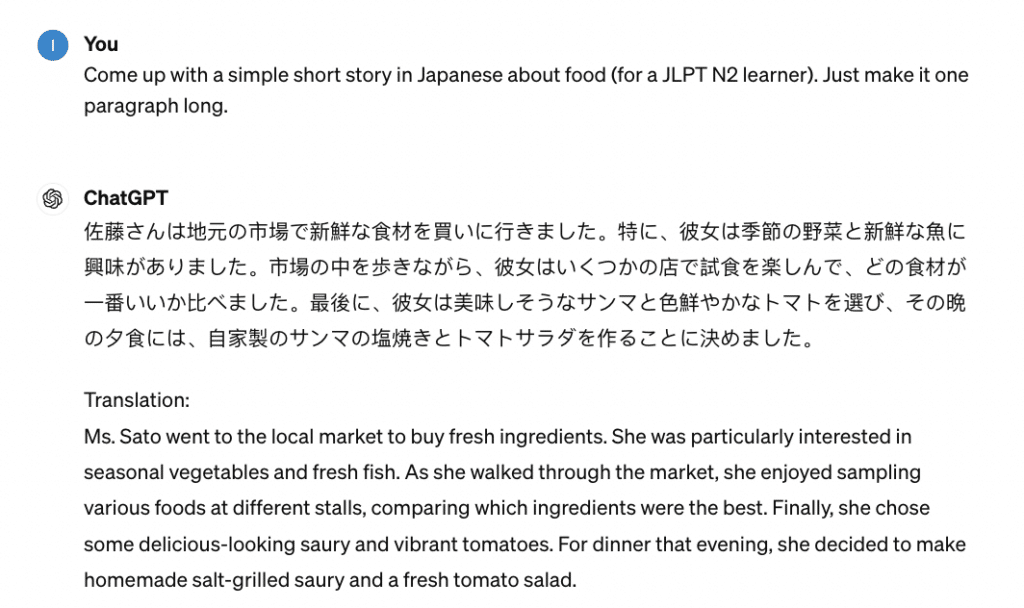
Example Prompts:
- Come up with a [language] short story about [theme] for [language level].
- Generate a graded reader-style story that’s for intermediate learners, then add a vocabulary list for it after.
10. Check out language learning bots
The GPT store has thousands of customized chatbots that you can download for free—and there are at least a few that are popular for language learning.
For example, Language Teacher | Ms. Smith already has more than 50,000 downloads. Another cool GPT is Language Learner, which offers interactive lessons, stories and even photos that you can practice describing:
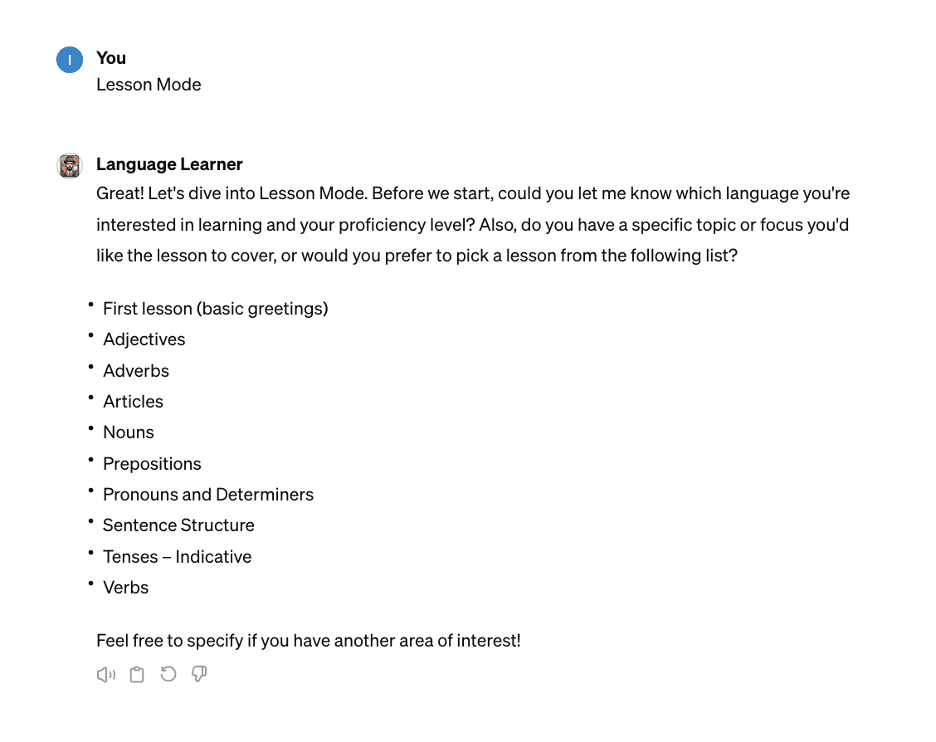
As an alternative, you can always make your own—you’ll just need to work on refining your prompts or instructions for ChatGPT.
Common Questions about ChatGPT

Can you learn a language with ChatGPT?
ChatGPT is very helpful as a supplementary resource for learning a language because it’s an all-in-one tool that’s quite intelligent. It can correct your grammar, help you practice vocabulary, be your conversation partner and even answer your questions about the language.
But just as with other apps and textbooks, it should be part of an all-around study plan. Aside from practicing with ChatGPT, it’s also important to talk to native speakers—maybe on a tutoring platform like italki—and immerse in content in your target language.
FluentU takes authentic videos—like music videos, movie trailers, news and inspiring talks—and turns them into personalized language learning lessons.
You can try FluentU for free for 2 weeks. Check out the website or download the iOS app or Android app.
P.S. Click here to take advantage of our current sale! (Expires at the end of this month.)
What languages is ChatGPT fluent in?
ChatGPT is constantly taking in new data so its language skills keep improving, but in general, it’s proficient in more than 50 languages, including English, Spanish, French, German and Chinese.
Still, it’s not as good at languages like Arabic, Thai, Turkish and Vietnamese. Rare languages online, like Tibetan, Basque and Mauri are not covered as much. I tried it out with Tibetan before, and a Tibetan monk classmate of mine confirmed that ChatGPT’s translation didn’t make sense at all!
Is ChatGPT free?
ChatGPT 3 is free for personal use, but for the more advanced model (GPT 4), you need to pay for a subscription. You should know, though, that even with a subscription, you still get a message limit, such as 40 messages per three hours.
What is the best AI for language learning?
ChatGPT is the most popular AI chatbot for language learning because it was the first of its kind to be released, but Claude, Gemini and Copilot have pretty advanced capabilities too. All of these have free versions, so feel free to test them out on your own and see which is your favorite.
AI is definitely here to stay. With its language capabilities getting constantly better, you’ll see ChatGPT (and other AI chatbots) become increasingly common in the language learning world.
So try out the ChatGPT strategies I’ve listed above. Once you find one that works for you, it’ll make your language learning journey more convenient, plus you might get your own ideas too!
And One More Thing...
If you dig the idea of learning on your own time from the comfort of your smart device with real-life authentic language content, you'll love using FluentU.
With FluentU, you'll learn real languages—as they're spoken by native speakers. FluentU has a wide variety of videos as you can see here:
FluentU has interactive captions that let you tap on any word to see an image, definition, audio and useful examples. Now native language content is within reach with interactive transcripts.
Didn't catch something? Go back and listen again. Missed a word? Hover your mouse over the subtitles to instantly view definitions.
You can learn all the vocabulary in any video with FluentU's "learn mode." Swipe left or right to see more examples for the word you’re learning.
And FluentU always keeps track of vocabulary that you’re learning. It gives you extra practice with difficult words—and reminds you when it’s time to review what you’ve learned. You get a truly personalized experience.
Start using the FluentU website on your computer or tablet or, better yet, download the FluentU app from the iTunes or Google Play store. Click here to take advantage of our current sale! (Expires at the end of this month.)

